This is the multi-page printable view of this section. Click here to print...
TWELITE (GOLD Series)
1 - TWELITE (GOLD Series)
Introduction
TWELITE® is a compact, low-power, and high-performance wireless module.
Equipped with an Arm® Cortex®-M4 core, it supports mid-range wireless communication compliant with IEEE802.15.4 and short-range communication compliant with ISO/IEC 14443.
It has obtained domestic radio certification in Japan, enabling rapid productization of wireless systems.
Features
- Ultra-compact package (13.97mm × 13.97mm × 2.5mm)
- Mid-range wireless communication compliant with global standard IEEE802.15.4
- PCB design that maximizes chip performance and ensures stable communication over long distances
- Our proprietary simple protocol stack “TWELITE NET”
- Short-range communication with NFC readers compliant with ISO/IEC 14443
- Widely used Arm Cortex-M4 architecture
- Excellent power-saving performance with minimum standby current of 350nA, contributing to battery life
- Equipped with 152KB SRAM and 640KB flash memory, supporting advanced communication application software
- 6-channel 12-bit ADC and 22 general-purpose digital I/O ports to connect various sensors
- 10-channel PWM output, applicable to LEDs and actuators
- Newly equipped 32-bit real-time clock
- Firmware development environment based on the free GNU Arm Embedded Toolchain
- Strong AES encryption with 128bit / 192bit / 256bit
- Certified under Japan’s ARIB STD-T66 (technical conformity certification)
Product Variants
The TWELITE wireless module (GOLD Series) is available in the following variants. Please select according to your application.
| Product Name | Model Number | Antenna Terminal | Remarks |
|---|---|---|---|
| TWELITE | MW-G-W | Wire antenna terminal(through-hole) | Antenna sold separately |
| MW-G-U | Coaxial antenna terminal(U.FL/IPEX) | Antenna sold separately | |
| TWELITE DIP | MW-G-DIP-P | On-board antenna | |
| MW-G-DIP-U | Coaxial antenna terminal(U.FL/IPEX) | Antenna sold separatelyMain unit is MW-G-W |
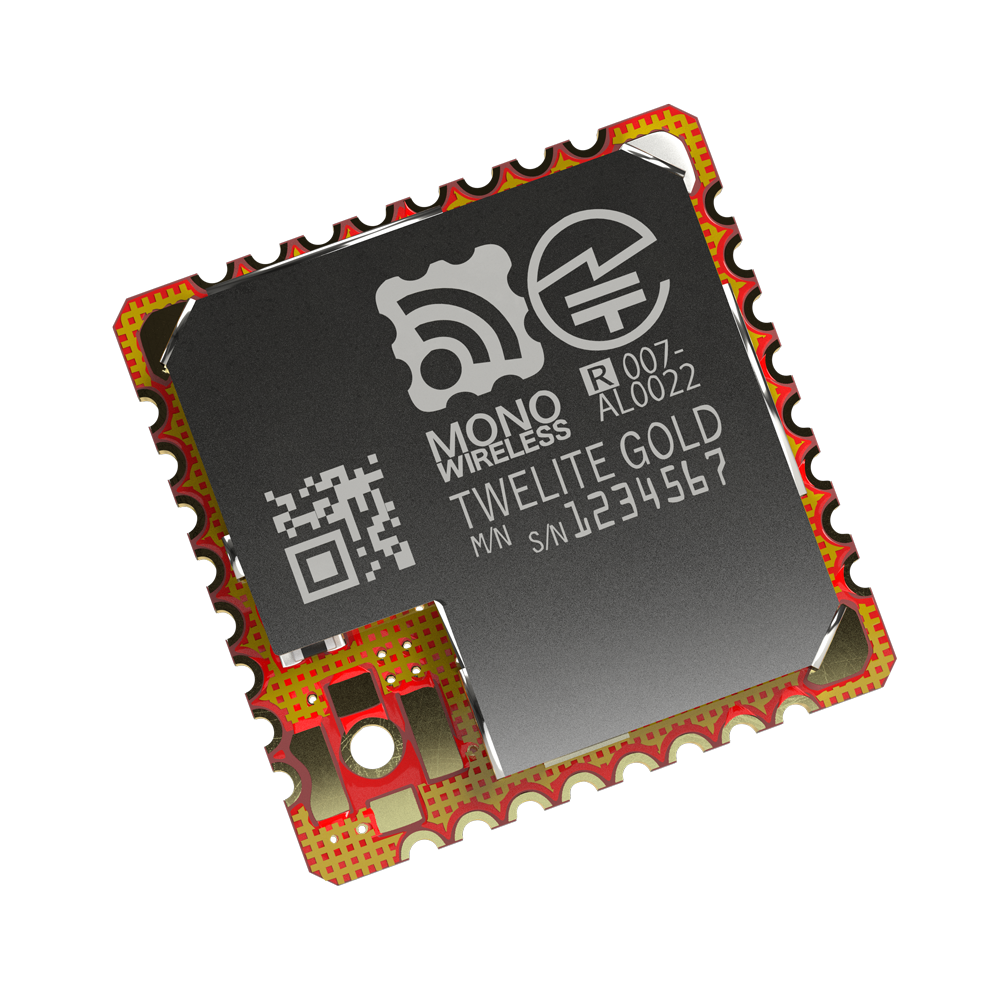
MW-G-W Appearance
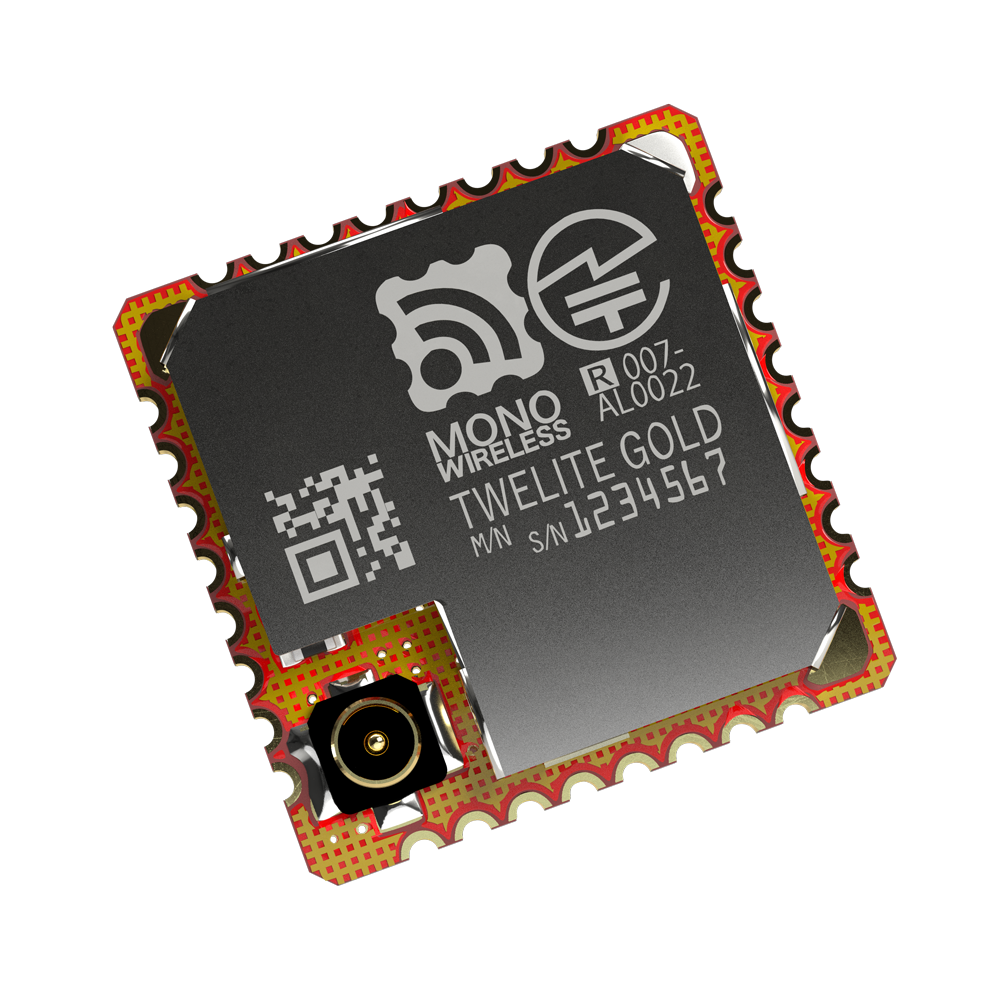
MW-G-U Appearance
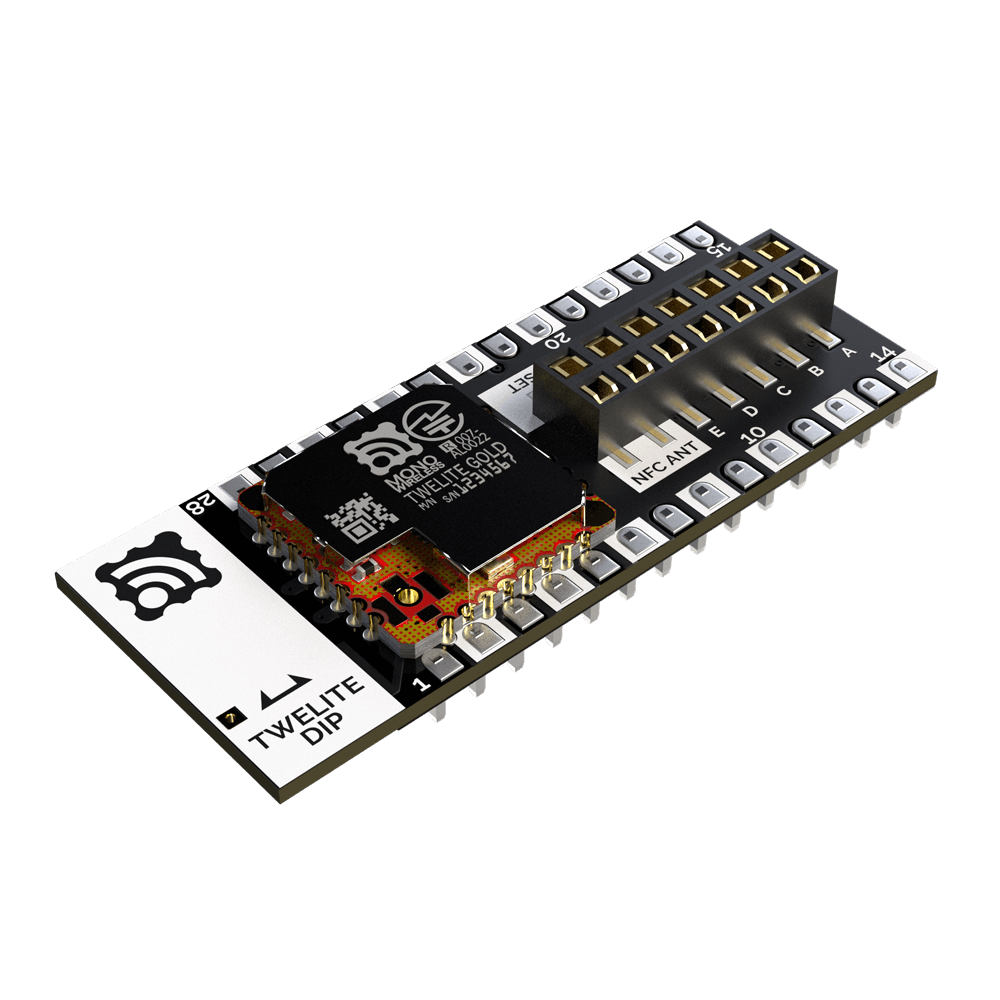
MW-G-DIP-P Appearance
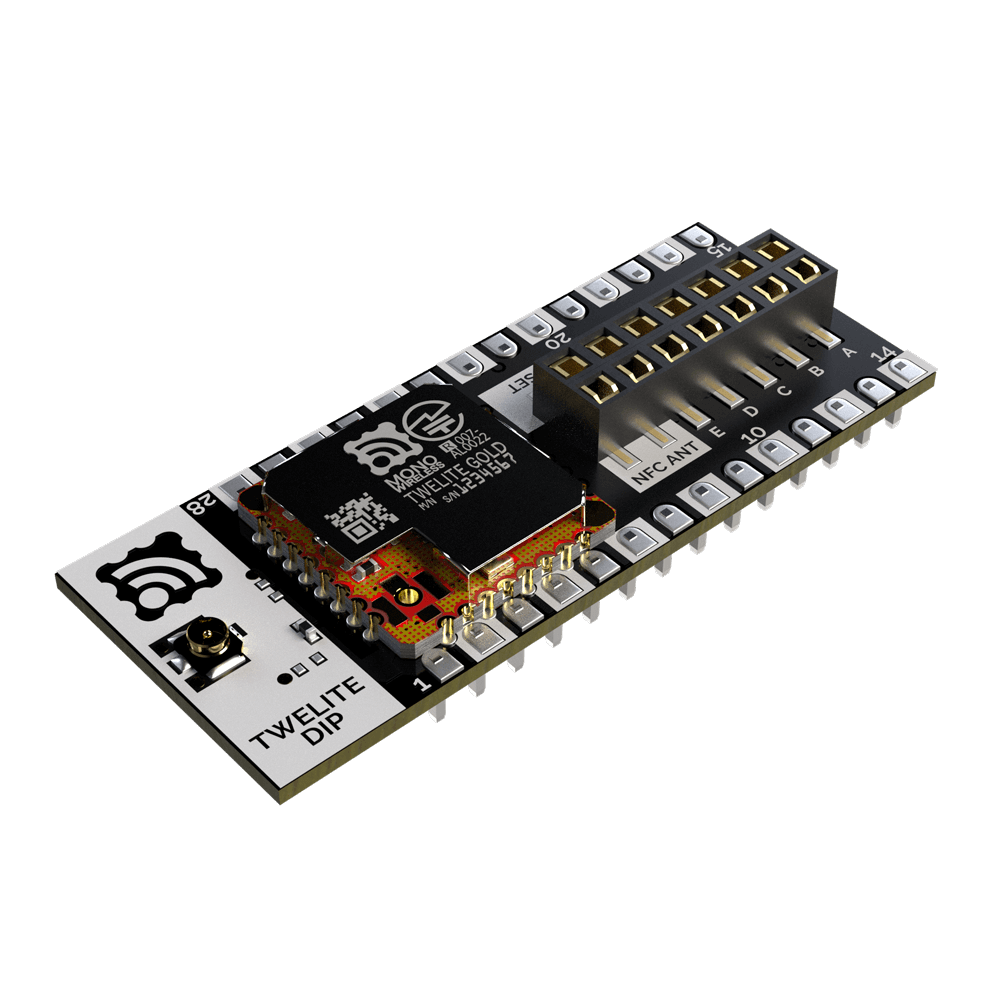
MW-G-DIP-U Appearance
In the following document, the tag SMD indicates sections related to MW-G-W/U, DIP for MW-G-DIP-P/U, and ALL for content relevant to all models.
Functions
ALL- 32-bit Arm Cortex-M4 processor
- Operating clock: 32MHz (clock can be adjusted from 12MHz to 48MHz to optimize power consumption)
- SRAM: 152KB
- Flash memory: 640KB
- EEPROM: 2KB (included in the built-in NFC chip)
- Watchdog timer and brown-out detection
- Power control for each block (digital/analog/SRAM/wireless)
- AES encryption circuit supporting 128bit/192bit/256bit
- 6x ADC (12bit)
- 10x PWM
- 2x Timers (32bit)
- 1x Comparator
- 2x UART
- 2x SPI (3 chip selects)
- 2x I2C
- 22x Digital IO
- 1x Quad SPI
- 1x RTC (32bit)
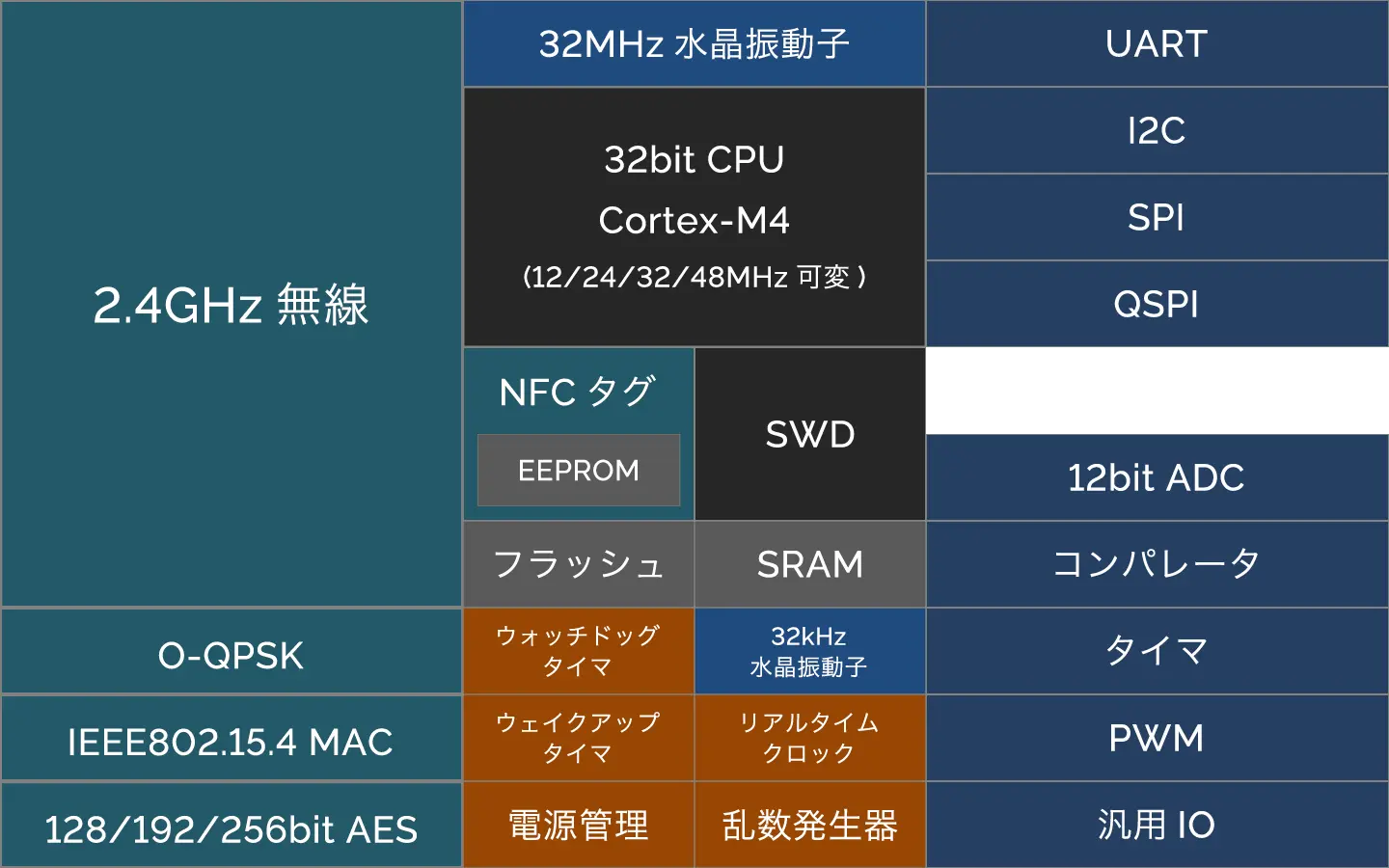
Block Diagram of TWELITE (GOLD Series)
2.4GHz Wireless
ALL| Item | TWELITE (GOLD Series) | Remarks |
|---|---|---|
| Communication | 2.4GHz IEEE 802.15.4 | |
| Protocol | TWELITE NET and IEEE 802.15.4 MAC | |
| Data Rate | 250kbps | |
| Modulation | O-QPSK, DSSS | |
| Channels | 16 | Varies by country |
| Max TX Power | 9.14dBm | 25°C, 3V, typ |
| RX Sensitivity | -99.7dBm | 25°C, 3V, typ |
Antennas
ALLFor a list of compatible antennas, please refer to our product information.
SMDA PCB-mountable antenna MW-A-P1934 is also available.
Certifications
ALL| TWELITE (GOLD Series) | |
|---|---|
| Certification Model | TWELITE GOLD |
| Technical Conformity Certification Number | 007-AL0022 |
When using TWELITE overseas, there may be various restrictions such as on the types of antennas that can be used.
Please contact us during the early stages of development.
NFC Tag
ALL| Item | TWELITE (GOLD Series) | Remarks |
|---|---|---|
| Communication | ISO/IEC 14443 Type A | |
| Protocol | NFC Forum Type 2 Tag | NXP® NTAG® |
| Data Rate | 106kbps | |
| SRAM | 64bytes | |
| EEPROM | 2KB | |
| Write Speed | 4.8ms | 4bytes, EEPROM |
| 0.8ms | 4bytes, SRAM | |
| 6.1ms | 64bytes, SRAM (FAST_WRITE) | |
| Max Distance | 100mm | Depends on antenna configuration |
Development Environment
ALLTWELITE STAGE SDK
TWELITE STAGE SDK is a dedicated firmware development environment for the TWELITE series provided by our company. Using the included application TWELITE STAGE APP, you can build and write firmware, as well as check the operation and change settings of existing firmware.
For usage instructions, refer to the documents included with the TWELITE STAGE SDK.
Documentation on the website may reflect newer versions of TWELITE STAGE SDK and the application, and thus may differ in content from the version you are using.
The TWELITE STAGE SDK consists of the following:
TWELITE STAGE APP (frontend for building, which uses command-line
makefor compilation and performs firmware writing): all exceptMWSDK(Note 1) andToolsunderMWSTAGE/Toolchain (utilities and command-line tools such as compiler): under
MWSTAGE/ToolsMWSDK library (libraries used in builds): under
MWSTAGE/MWSDK(Note 1)
Note 1: The
MWSDKfolder may contain older library versions. In such cases, folder names likeMWSDK20XX_YYare used.The toolchain
gccand the MWSDK library version directly affect the generated binaries.
Distribution of TWELITE STAGE SDK
The TWELITE STAGE SDK for TWELITE GOLD is distributed through our support service.
Below are the major versions currently available:
MWSTAGE2025_08distributed in August 2025- STAGE App:
2.4.4 - Toolchain:
gcc 12.2.1 20221205 - MWSDK Library:
MWSDK2025_08
- STAGE App:
TWELITE GOLD-Specific Development Information
The .../MWSDK/TWENET/current/index.html file under the MWSDK folder contains descriptions about build methods and APIs.
About MCUXpresso
MCUXpresso is a firmware development environment provided by NXP Semiconductors N.V., the manufacturer of the JN5189 semiconductor used in TWELITE (GOLD Series). It allows not only building and writing firmware but also debugging using MCU-Link.
About Software Licensing
When developing firmware using the TWELITE STAGE SDK provided by Mono Wireless Inc., please refer to the license descriptions in the LICENSE folder under the MWSDK library as the primary source. English versions of the licenses are available, but in the event of any dispute or discrepancy, the Japanese version shall take precedence.
MW-SLA-1J— Mono Wireless Software License Agreement (intended for commercial use)MW-OSSLA-1J— Mono Wireless Open Source Software License Agreement (considering non-commercial use)MW-SLA-1E1,MW-OSSLA-1E— English versions of the above
- Refer to the license descriptions included in the source code to understand the applicable license.
- Source code created by Mono Wireless Inc. is generally licensed under either
MW-SLAorMW-OSSLA.
- Source code created by Mono Wireless Inc. is generally licensed under either
- For tool licenses, refer to the distribution directories of the TWELITE STAGE SDK.
- For the TWELITE STAGE APP license, refer to the contents under
MWSTAGE/TWELITE_Stage/LICENSEin the SDK distribution.
- For the TWELITE STAGE APP license, refer to the contents under
Pin Assignment
Pin Number
SMD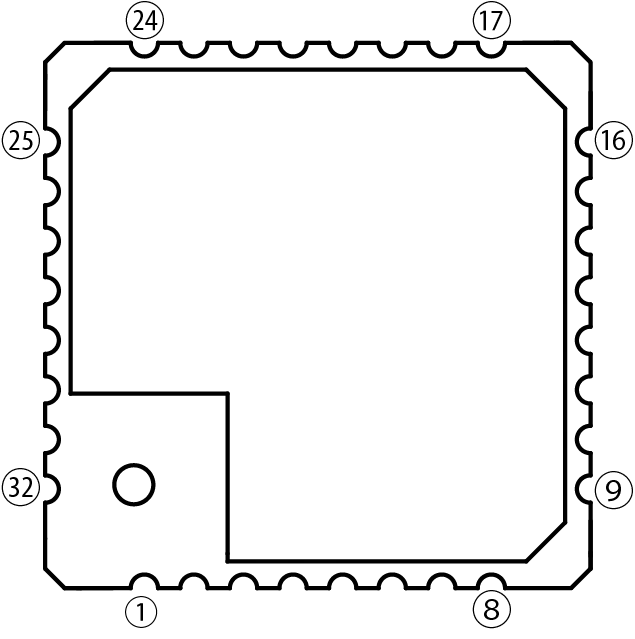
Pin Number Assignment

Pin Number Assignment (DIP)
Pin Functions
ALLThe typical functions are shown in the table below.
| Name | Function |
|---|---|
| PIO | Peripheral Input/Output |
| PWM | Pulse Width Modulation Output |
| TXD | UART Data Transmission |
| RXD | UART Data Reception |
| RTS | UART Data Transmission Request Output |
| CTS | UART Data Transmission Request Input |
| SCL | I2C Serial Clock |
| SDA | I2C Serial Data |
| SCK | SPI Serial Clock |
| MOSI | SPI Controller Output (PICO) |
| MISO | SPI Controller Input (POCI) |
| SSELN | SPI Peripheral Select (CS) |
| Name | Function |
|---|---|
| IO | Quad SPI Serial Data |
| CSN | Quad SPI Chip Select |
| CLK | Quad SPI Serial Clock |
| MAT | Timer Output |
| CAP | Timer Input |
| OUT | Comparator Output |
| ACP | Comparator + Input |
| ACM | Comparator - Input |
| SWDIO | SWD Serial Data |
| SWO | SWD Trace Port |
| SWCLK | SWD Serial Clock |
| ISPENT | ISP Entry |
| ISPSEL | ISP Mode Select |
The typical assignments of functions are shown in the table below.
| SMD# Note1 | DIP# (14P) Note1 | IO Note2 | PWM Note3 | ADC Note3 | UART Note3 | I2C Note3 | SPI Note3 | Quad SPI Note3 | Timer (CT32) Note3 | Comparator Note3 | SWD ISP Note3 |
|---|---|---|---|---|---|---|---|---|---|---|---|
| 1 | 6 | PIO0 | PWM0 | TXD1 | SCK1 | ||||||
| 2 | 7(PRG) | PIO5 | RTS0 | SSELN0MISO1SSELN1(2) | ISPENT | ||||||
| 3 | 5 | PIO2 | PWM2 | RXD0 | SCK0MOSI1 | ||||||
| 4 | 8 | PIO3 | PWM3 | TXD0 | MISO0SSELN1(0) | ||||||
| 5 | 28(VCC) | VCC | |||||||||
| 6 | 9 | PIO7 | PWM7 | CTS0RXD1 | SDA1 | MISO0 | CT32B1MAT1 | ||||
| 7 | 4 | PIO6 | PWM6 | RTS0TXD1 | SCL1 | SCK0 | CT32B1MAT0 | ||||
| 8 | 10(TXD) | PIO8 | PWM8 | TXD0 | MOSI0 | CT32B0MAT0 | OUT | ||||
| 9 | 3(RXD) | PIO9 | PWM9 | RXD0 | SSELN0 | CT32B1CAP1 | |||||
| 10 | 11(A) | PIO14 | PWM1 | ADC0 | SSELN1(1) | CT32B0CAP1 | SWO | ||||
| 11 | 12 | PIO12 | PWM0 | SCL1 | MOSI0 | OUT | SWCLK | ||||
| 12 | 13 | PIO4 | PWM4 | CTS0 | MOSI0SSELN1(1) | ISPSEL | |||||
| 13 | 15(SET) | PIO13 | PWM2 | SDA1 | MOSI0 | SWDIO | |||||
| 14 | 2 | PIO10 | TXD1 | SCL0 | SCK0 | CT32B0CAP0 | |||||
| 15 | 16 | PIO1 | PWM1 | RXD1 | MISO1 | ||||||
| 16 | 17 | PIO0 | PWM0 | TXD1 | SCK1 | ||||||
| 17 | 19 | PIO11 | RXD1 | SDA0 | MISO0 | CT32B1CAP0 | |||||
| 18 | 18 | PIO20 | PWM8 | TXD1 | IO2 | ACP | |||||
| 19 | 20 | PIO21 | PWM9 | IO1 | ACM | SWO | |||||
| 20 | 1,14 | GND | |||||||||
| 21 | 21(RST) | RSTN | |||||||||
| 22 | 24(A) | PIO14 | PWM1 | ADC0 | SSELN1(1) | CT32B0CAP1 | SWO | ||||
| 23 | 22(B) | PIO15 | PWM3 | ADC1 | SCL0 | SCK1 | OUT | ||||
| 24 | 23(C) | PIO16 | PWM5 | ADC2 | SDA0 | SSELN1(0) | CSN | ||||
| 25 | 25(D) | PIO17 | PWM6 | ADC3 | MOSI1 | IO3 | SWO | ||||
| 26 | 26(E) | PIO18 | PWM7 | ADC4 | TXD0 | MISO1 | CLK | CT32B0MAT1 | |||
| 27 | 27 | PIO19 | PWM4 | ADC5 | RXD0RXD1 | IO0 | |||||
| 28 | 1,14(GND) | GND | |||||||||
| 29 | N/A(ANT R) | LA | |||||||||
| 30 | 1,14GND | GND | |||||||||
| 31 | N/A(ANT L) | LB | |||||||||
| 32 | 1,14GND | GND |
※1. Pin numbers. The number and assignment of pin numbers differ between TWELITE and TWELITE DIP. Normally, IO names are used to identify pins.
※2. IO names of the pins. These names are used in semiconductor datasheets and TWELITE application development. Our technical support also refers to pins by IO names in principle.
※3. This table lists representative functions. Only a portion of these functions may be supported by the TWENET library.
For compatibility with the TWELITE BLUE/RED series, the following pins are internally connected:
- PIO0: SMD#1 and SMD#16
- PIO14: SMD#10 and SMD#22
It is recommended to connect all GND pins SMD#28, 30, and 32. However, operation without connecting them is also possible.
Even when these pins are left unconnected, no significant change in wireless performance has been observed.
Electrical Characteristics
ALLAbsolute Maximum Ratings
| Min | Max | ||
|---|---|---|---|
| Power Supply | -0.3 | 3.96 | V |
| Reset | -0.3 | 3.96 | V |
| Digital IO | -0.3 | 3.96 | V |
| ADC | -0.3 | 3.96 | V |
| NFC (LA/LB) | -0.3 | 4.6 | V |
- The values are based on the semiconductor datasheet.
Recommended Operating Conditions
| Symbol | Condition | Min | Max | ||
|---|---|---|---|---|---|
| Supply Voltage | VCC | 1.9 | 3.6 | V | |
| Operating Temp | TJ | No condensationMW-G-W | -40 | 105 | °C |
| No condensationMW-G-U | -40 | 90 | °C |
- The values are based on the semiconductor datasheet.
DC Characteristics
| Symbol | Condition | Min | Typ | Max | ||
|---|---|---|---|---|---|---|
| Current Consump. | ICC | Sleep, SRAM not retained, no timer | 350 | nA | ||
| Sleep, SRAM not retained, timer enabled | 800 | nA | ||||
| Sleep, SRAM retained (4KB), timer enabled | 1025 | nA | ||||
| Sleep, SRAM retained (8KB), timer enabled | 1120 | nA | ||||
| Active, TX (10dBm) | 20.28 | mA | ||||
| Active, TX (3dBm) | 9.44 | mA | ||||
| Active, TX (0dBm) | 7.36 | mA | ||||
| Active, RX | 4.3 | mA |
- The values are based on the semiconductor datasheet.
I/O Characteristics
| Symbol | Condition | Min | Typ | Max | ||
|---|---|---|---|---|---|---|
| PIO Internal Pull-up | Rpu(int)(PIO) | 40 | 50 | 60 | kΩ | |
| RSTN Internal Pull-up | Rpu(int)(RSTN) | 40 | 50 | 60 | kΩ | |
| PIO Internal Pull-down | Rpdn(int)(PIO) | 40 | 50 | 60 | kΩ | |
| IO High Input | VIH | 0.7*VCC | VCC | V | ||
| IO Low Input | VIL | -0.3 | 0.27*VCC | V | ||
| IO High Output | VOH | PIO0-9,12-162mA load (VCC=3.6V) | 3.3 | VCC | V | |
| PIO0-9,12-162mA load (VCC=3.0V) | 2.65 | VCC | V | |||
| PIO0-9,12-162mA load (VCC=2.4V) | 2 | VCC | V | |||
| PIO0-9,12-162mA load (VCC=1.9V) | 1.4 | VCC | V | |||
| PIO17-215mA load (VCC=3.6V) | 3.2 | VCC | V | |||
| PIO17-215mA load (VCC=3.0V) | 2.6 | VCC | V | |||
| PIO17-215mA load (VCC=2.4V) | 2.05 | VCC | V | |||
| PIO17-215mA load (VCC=1.9V) | 1.35 | VCC | V | |||
| PIO10,112mA load (VCC=3.6V) | 3.3 | VCC | V | |||
| PIO10,112mA load (VCC=3.0V) | 2.66 | VCC | V | |||
| PIO10,112mA load (VCC=2.4V) | 2.1 | VCC | V | |||
| PIO10,112mA load (VCC=1.9V) | 1.15 | VCC | V | |||
| IO Low Output | VOL | 0 | 0.4 | V |
- The values are based on the semiconductor datasheet.
ADC Characteristics
| Symbol | Condition | Min | Typ | Max | ||
|---|---|---|---|---|---|---|
| Input Voltage | Vi | 0 | VCC | V | ||
| Full Scale Range | FSR | After calibration | 3.56 | 3.6 | 3.62 | V |
| Resolution | 12 | bits | ||||
| Current Consumption | IADCx | x=05 | 100 | uA | ||
| Integral Nonlinearity | INL | 1.1 | LSB | |||
| Differential Nonlinearity | DNL | 0.85 | LSB | |||
| Offset Error | EO | After calibration | -4.5 | 4.5 | mV | |
| Gain Error | EG | After calibration | -40 | 0 | 20 | mV |
| Sampling Frequency | fs | Single channel | 78.4 | 100 | 190 | ksps |
- The values are based on the semiconductor datasheet.
Mechanical Characteristics
External Dimensions
SMD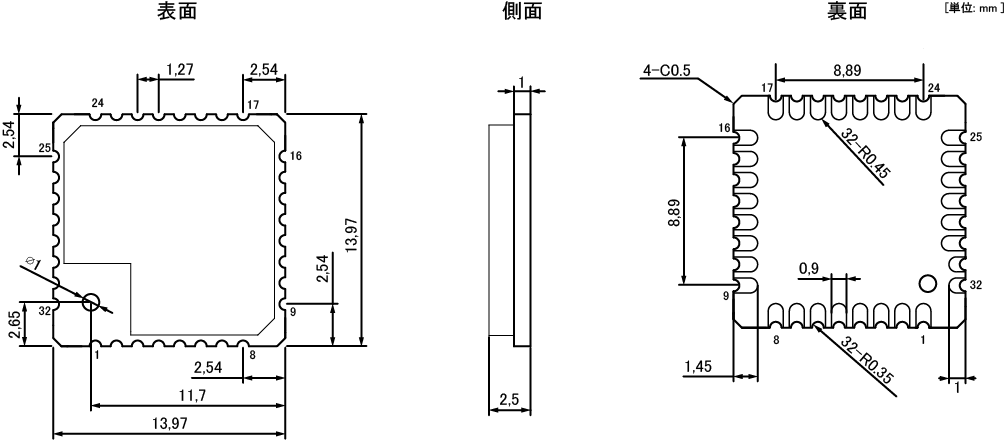
Outline Drawing
- Dimensions: 13.97mm x 13.97mm x 2.5mm
- Weight: 0.84g (MW-G-W), 0.86g (MW-G-U)

Outline Drawing (Board Antenna)

Outline Drawing (U.FL)
- Dimensions: 44.7mm x 18.3mm x 8.1mm
- Weight: 3.81g (MW-G-DIP-P), 3.83g (MW-G-DIP-U)
Recommended Pad Dimensions
SMD
- Do not place silkscreen or through-holes on the receiving PCB area that contacts the module underside.
- When connecting a wire antenna such as a stick antenna, provide a slot on the receiving PCB and solder from the underside of the module. (See Antenna Opening)
- Use a metal mask thickness in the range of t = 0.12–0.15mm. Due to the metal mask and reflow conditions, solder fillets may not form on some half-cut vias on one side of the module.
Environmental Regulations
- Compliant with RoHS (10 substances)
Shield Can
The shield can is soldered at two diagonal points.
Antenna Opening
SMDWhen mounting TWELITE to a custom PCB and using a wire antenna such as a stick antenna, create an opening on the board and solder from the underside.
The figure below shows an example opening.
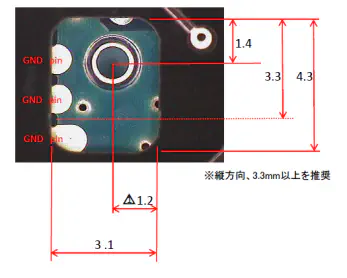
In this example, pins 29, 30, 31, and 32 (LA, GND, LB, GND) are left unconnected to allow for a wider opening.
Reflow Conditions
SMDRecommended Reflow Profile
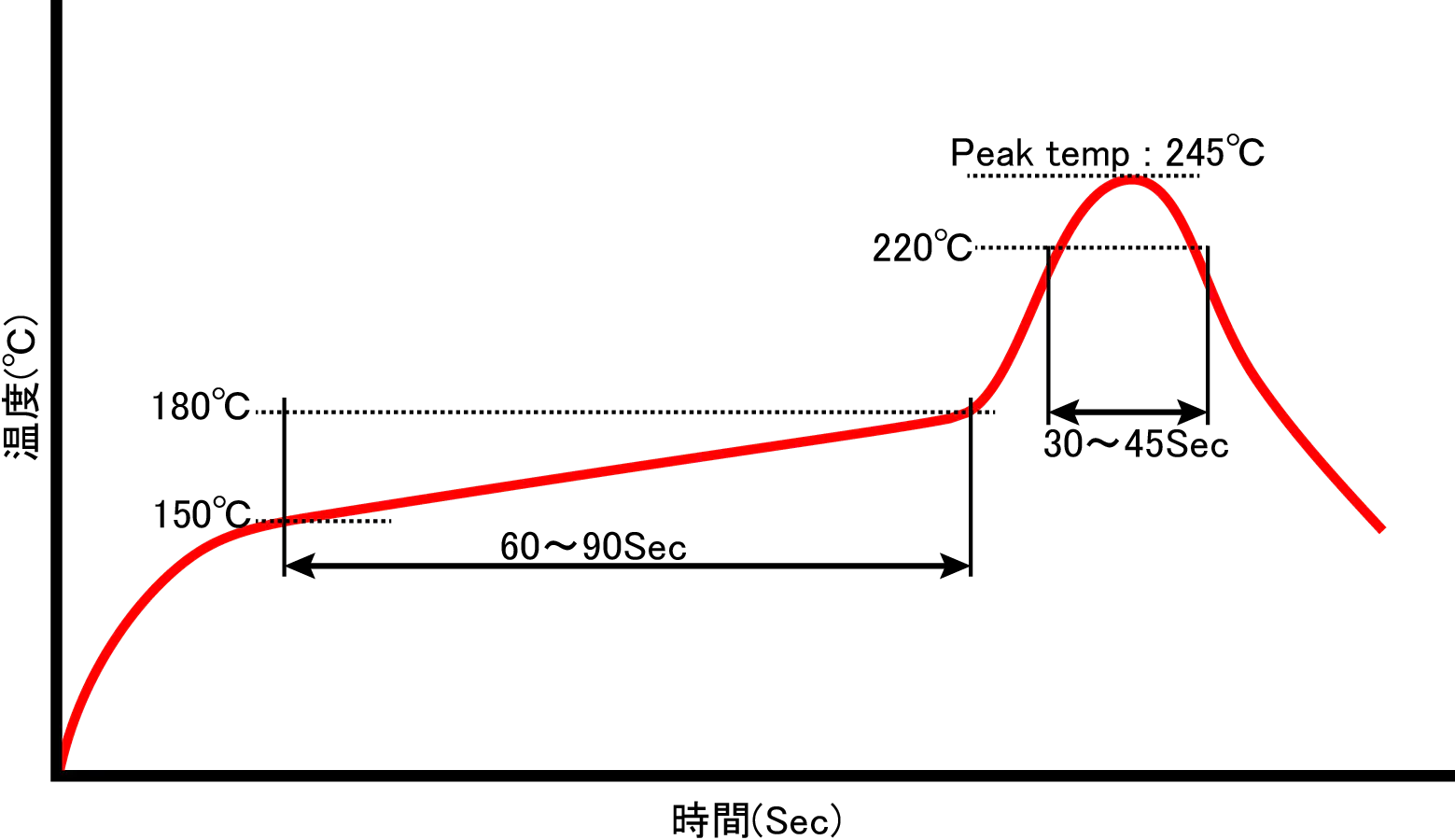
Reflow Profile
| Preheating | Main Heating | Peak Temp | Reflow Count |
|---|---|---|---|
| 150 | 220°C/30-45sec | 245°C | 1 |
Ordering Information
Product Codes
ALL| Product Name | Product Code | Sales Type | Packaging | MOQ | SPQ |
|---|---|---|---|---|---|
| TWELITE | MW-G-W | Retail | Individual Pack | 1 | 1 |
| MW-G-W-BULK | Wholesale | Cut Tape/Tray | 100 | 100 | |
| MW-G-W-REEL | Wholesale | Reel | 1000 | 1000 | |
| MW-G-U | Retail | Individual Pack | 1 | 1 | |
| MW-G-U-BULK | Wholesale | Cut Tape/Tray | 100 | 100 | |
| MW-G-U-REEL | Wholesale | Reel | 1000 | 1000 | |
| TWELITE DIP | MW-G-DIP-P | Retail | Individual Pack | 1 | 1 |
| MW-G-DIP-P-BULK | Wholesale | Tray | 100 | 100 | |
| MW-G-DIP-U | Retail | Individual Pack | 1 | 1 | |
| MW-G-DIP-U-BULK | Wholesale | Tray | 100 | 100 |
Product codes are subject to change. For the latest codes, please refer to our website.
Packaging
SMDTaping Dimensions
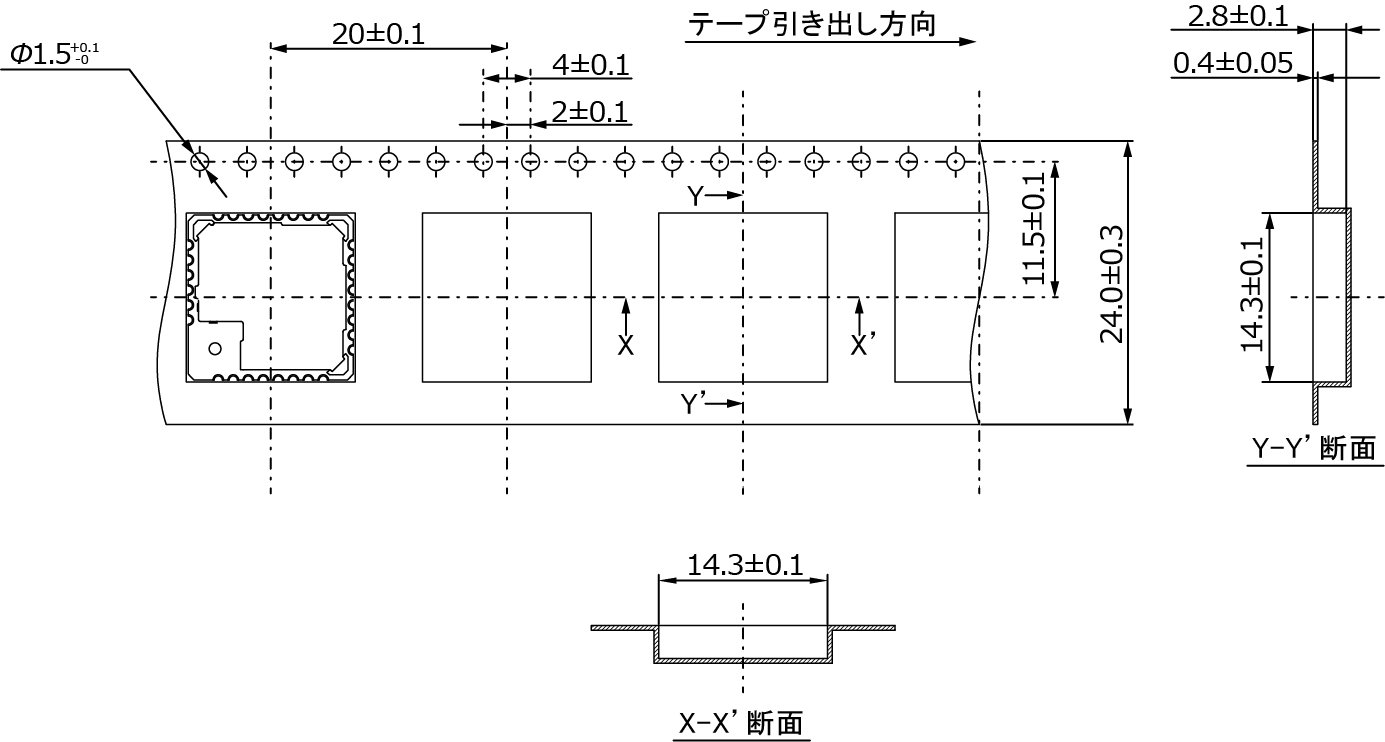
Reel Dimensions

Precautions
Mounting Precautions
SMD- The product should be reflow soldered only once under our recommended reflow conditions. Please note that solder inside the product will re-melt during reflow.
- This product absorbs moisture when left in a natural environment. Please perform reflow mounting within 72 hours after opening.
- Ensure adequate electrostatic discharge (ESD) protection.
- If more than 72 hours have passed after opening, perform baking under the following conditions before use:
- Baking in reels is not allowed; transfer to trays, etc., before baking.
- Bake at 90°C for 48 hours, up to one time only.
- Please note that multiple LOT numbers may be mixed in a single package.
- Solder fillets on soldered parts of components mounted inside the product are not required.
- This product is intended for mounting on glass epoxy substrates. If mounting on substrates made of materials other than glass epoxy (e.g., ceramics), please conduct thorough evaluation before use.
- Due to the nature of components mounted inside the product, they are highly sensitive to static electricity. Ensure full ESD protection when handling.
- If stress is applied to the shield case, it may come off. Please handle with care.
- For hand soldering, please follow these conditions: temperature below 350°C, within 3 seconds (package surface temperature should be below 150°C).
Export Regulations
ALLTWELITE is equipped with an AES encryption circuit, and we judge it as a product subject to export control classification. If you require a parameter sheet for export classification, please contact us.
In overseas markets, radio certification may be required. Please consult us at an early stage.
Product Markings
ALLProduct logos, certification numbers, and other markings printed on the product may change without notice.
Factory Firmware
ALLWriting of TWELITE firmware is performed as part of product inspection during manufacturing (to confirm that information such as serial number and MAC address written to the chip is valid). We cannot guarantee information such as firmware version even upon customer request. The presence or type of firmware written to TWELITE STICK at the time of factory shipment may change without notice. We do not rewrite firmware on shipped products. Please use the TWELITE STAGE App or the Python tweliter module.
Storage Precautions
ALLStore between 0°C and 40°C, avoiding high temperature and humidity.
SMDUse the product within 6 months after delivery.
Usage Precautions
ALLWhen using the product, always conduct evaluations and confirmations in the actual environment. For applications requiring very high reliability or those involving human life, please contact your distributor in advance.
Revision History
| Version | Revision Date | Details of Changes |
|---|---|---|
| 1.0.0b | 2025-08-08 | Updated SDK version information |
| 1.0.0 | 2025-06-04 | First Edition |
| 1.0.0rc2 | 2024-07-16 | Pre-release Version |
Arm® and Cortex® are registered trademarks of Arm Limited.
NXP® and NTAG® are registered trademarks of NXP B.V.
2 - TWELITE (GOLD Series)
Introduction
TWELITE® is a compact, low-power, high-performance wireless module.
Equipped with an Arm® Cortex®-M4 core, it supports medium-range wireless communication compliant with IEEE802.15.4 and short-range communication compliant with ISO/IEC 14443.
Certified for radio use in Japan, it enables rapid product development for wireless systems.
Features
- Ultra-compact body package (13.97mm × 13.97mm × 2.5mm)
- Medium-range wireless communication compliant with the global standard IEEE802.15.4
- PCB design that maximizes chip performance and ensures stable communication over long distances
- Our proprietary simple protocol stack “TWELITE NET”
- Short-range wireless communication with NFC readers compliant with ISO/IEC 14443
- Widely used Arm Cortex-M4 architecture
- Excellent power-saving performance with standby current as low as 350nA, contributing to longer battery life
- Equipped with 152KB SRAM and 640KB flash memory to support advanced communication application software
- Six-channel 12-bit ADC and 22 general-purpose digital I/O ports to connect various sensors
- Ten channels of PWM output usable for LEDs and actuators
- Newly added 32-bit real-time clock
- Firmware development environment based on the freely available GNU Arm Embedded Toolchain
- Strong AES encryption: 128bit / 192bit / 256bit
- Certified under Japan’s ARIB STD-T66 construction design certification (technical conformity)
Product Variants
The TWELITE Wireless Module (GOLD Series) comes in the following variations. Please select according to your application.
| Product Name | Model No. | Antenna Terminal | Remarks |
|---|---|---|---|
| TWELITE | MW-G-W | Wire antenna terminal(through-hole) | Antenna sold separately |
| MW-G-U | Coaxial antenna terminal(U.FL/IPEX) | Antenna sold separately | |
| TWELITE DIP | MW-G-DIP-P | PCB antenna | |
| MW-G-DIP-U | Coaxial antenna terminal(U.FL/IPEX) | Antenna sold separatelyMain body: MW-G-W |

MW-G-W Appearance

MW-G-U Appearance

MW-G-DIP-P Appearance

MW-G-DIP-U Appearance
In the following documentation, references related to MW-G-W/U are marked as SMD , those related to MW-G-DIP-P/U as DIP , and those applicable to all as ALL .
Functions
ALL- 32-bit Arm Cortex-M4 processor
- Operating clock: 32MHz (variable between 12MHz and 48MHz to optimize power consumption)
- SRAM: 152KB
- Flash memory: 640KB
- EEPROM: 2KB (mounted on internal NFC chip)
- Watchdog timer, brown-out detection
- Power control for each block (Digital/Analog/SRAM/Wireless)
- AES encryption circuit: 128bit / 192bit / 256bit
- 6x ADC (12-bit)
- 10x PWM
- 2x Timer (32-bit)
- 1x Comparator
- 2x UART
- 2x SPI (with 3 chip selects)
- 2x I2C
- 22x Digital IO
- 1x Quad SPI
- 1x RTC (32-bit)

Block Diagram of TWELITE (GOLD Series)
2.4GHz Wireless
ALL| Item | TWELITE (GOLD Series) | Remarks |
|---|---|---|
| Communication | 2.4GHz IEEE 802.15.4 | |
| Protocol | TWELITE NET and IEEE 802.15.4 MAC | |
| Data Rate | 250kbps | |
| Modulation | O-QPSK, DSSS | |
| Channels | 16 | Varies depending on country |
| Max TX Power | 9.14dBm | 25°C, 3V, typical |
| RX Sensitivity | -99.7dBm | 25°C, 3V, typical |
Antenna
ALLFor a list of compatible antennas, refer to our product information.
SMDA board antenna that can be mounted on the PCB (MW-A-P1934) is also available. See Board antenna (MW-A-P1934).
Certification
ALL| TWELITE (GOLD Series) | |
|---|---|
| Certification Model Name | TWELITE GOLD |
| Technical Conformity ID | 007-AL0022 |
| FCC ID | TBA |
| IC ID | TBA |
When using TWELITE overseas, please note that restrictions may apply to the type of antennas and other conditions.
Please consult us during the early stage of your development.
Depending on the country or region, it may be required to display FCC ID or IC ID on the TWELITE module or the product.
If unsure, please contact us for confirmation.
NFC Tag
ALL| Item | TWELITE (GOLD Series) | Remarks |
|---|---|---|
| Communication | ISO/IEC 14443 Type A | |
| Protocol | NFC Forum Type 2 Tag | NXP® NTAG® |
| Data Rate | 106kbps | |
| SRAM | 64 bytes | |
| EEPROM | 2KB | |
| Write Time | 4.8ms | 4 bytes, EEPROM |
| 0.8ms | 4 bytes, SRAM | |
| 6.1ms | 64 bytes, SRAM (FAST_WRITE) | |
| Max Range | 100mm | Depends on antenna, etc. |
Development Environment
ALLTWELITE STAGE SDK
TWELITE STAGE SDK is a dedicated firmware development environment for the TWELITE series provided by our company. By using the included TWELITE STAGE APP, you can build, write firmware, verify operation, and configure settings.
For usage instructions, please refer to the documentation included with the TWELITE STAGE SDK.
Materials on the website may reflect newer versions of the TWELITE STAGE SDK or applications, which may differ from the specifications of the version you are using.
The TWELITE STAGE SDK includes the following components:
TWELITE STAGE APP (frontend for build operations; executes builds via
makeusing the command-line tool and writes firmware) Located inMWSTAGE/, excludingMWSDK(note 1) andTools.Toolchain (compiler and other command-line utilities) Located under the
MWSTAGE/Toolsfolder.MWSDK Libraries (used during builds) Located under
MWSTAGE/MWSDK(note 1)
Note 1: In addition to the latest version, older library versions may also be included in the
MWSDKfolder. These are placed in folders named by version, such asMWSDK20XX_YY.The binaries generated during the build are directly affected by the version of the
gcctoolchain and the MWSDK library.
Distribution of TWELITE STAGE SDK
The TWELITE STAGE SDK for TWELITE GOLD is distributed by our support team.
Below are the currently distributed versions:
MWSTAGE2024_07G(Distributed in July 2024)- STAGE App:
2.4.1 - Toolchain:
gcc 12.2.1 20221205 - MWSDK Library:
MWSDK2024_07G
- STAGE App:
Development Information Specific to TWELITE GOLD
Details on build methods and APIs are documented in .../MWSDK/TWENET/current/index.html under the MWSDK folder.
About MCUXpresso
MCUXpresso is a firmware development environment provided by NXP Semiconductors N.V., the manufacturer of the JN5189 semiconductor mounted on the TWELITE (GOLD Series). In addition to build and write capabilities, it also supports debugging using MCU-Link.
Software License Agreement
For software provided by MONO WIRELESS Inc., please refer to the license descriptions in the LICENSE folder under the MWSDK library within the TWELITE STAGE SDK when developing firmware. Although English versions are available, in the event of conflicting interpretations, the Japanese version shall take precedence.
MW-SLA-1J・・・ MONO WIRELESS Software License Agreement (for commercial use)MW-OSSLA-1J・・・ MONO WIRELESS Open Source Software License Agreement (includes non-commercial use)MW-SLA-1E1,MW-OSSLA-1E・・・ English versions of the above
- Please check the license description in the source code to understand which license applies.
- Source code created by MONO WIRELESS Inc. is generally licensed under
MW-SLAorMW-OSSLA.
- Source code created by MONO WIRELESS Inc. is generally licensed under
- For licenses related to tools, refer to the distribution directory of the TWELITE STAGE SDK.
- The license for the TWELITE STAGE APP is located under
MWSTAGE/TWELITE_Stage/LICENSE.
- The license for the TWELITE STAGE APP is located under
Pin Assignment
Pin Number
SMD
Pin Number Assignment

Pin Number Assignment (DIP)
Functions of Each Pin
ALLThe representative functions are shown in the table below.
| Name | Function |
|---|---|
| PIO | Peripheral input/output |
| PWM | Pulse-width modulation output |
| TXD | UART Data Transmission |
| RXD | UART Data Reception |
| RTS | UART Request to Send (output) |
| CTS | UART Clear to Send (input) |
| SCL | I2C Serial Clock |
| SDA | I2C Serial Data |
| SCK | SPI Serial Clock |
| MOSI | SPI Controller Output (PICO) |
| MISO | SPI Controller Input (POCI) |
| SSELN | SPI Peripheral Select (CS) |
| Name | Function |
|---|---|
| IO | Quad SPI Serial Data |
| CSN | Quad SPI Chip Select |
| CLK | Quad SPI Serial Clock |
| MAT | Timer Output |
| CAP | Timer Input |
| OUT | Comparator Output |
| ACP | Comparator + Input |
| ACM | Comparator - Input |
| SWDIO | SWD Serial Data |
| SWO | SWD Trace Port |
| SWCLK | SWD Serial Clock |
| ISPENT | ISP Entry |
| ISPSEL | ISP Mode Select |
The typical function assignments are shown in the following table.
| SMD#Note 1 | DIP# (14P)Note 1 | IONote 2 | PWMNote 3 | ADCNote 3 | UARTNote 3 | I2CNote 3 | SPINote 3 | QuadSPINote 3 | Timer(CT32)Note 3 | ComparatorNote 3 | SWDISPNote 3 |
|---|---|---|---|---|---|---|---|---|---|---|---|
| 1 | 6 | PIO0 | PWM0 | TXD1 | SCK1 | ||||||
| 2 | 7(PRG) | PIO5 | RTS0 | SSELN0MISO1SSELN1(2) | ISPENT | ||||||
| 3 | 5 | PIO2 | PWM2 | RXD0 | SCK0MOSI1 | ||||||
| 4 | 8 | PIO3 | PWM3 | TXD0 | MISO0SSELN1(0) | ||||||
| 5 | 28(VCC) | VCC | |||||||||
| 6 | 9 | PIO7 | PWM7 | CTS0RXD1 | SDA1 | MISO0 | CT32B1MAT1 | ||||
| 7 | 4 | PIO6 | PWM6 | RTS0TXD1 | SCL1 | SCK0 | CT32B1MAT0 | ||||
| 8 | 10(TXD) | PIO8 | PWM8 | TXD0 | MOSI0 | CT32B0MAT0 | OUT | ||||
| 9 | 3(RXD) | PIO9 | PWM9 | RXD0 | SSELN0 | CT32B1CAP1 | |||||
| 10 | 11(A) | PIO14 | PWM1 | ADC0 | SSELN1(1) | CT32B0CAP1 | SWO | ||||
| 11 | 12 | PIO12 | PWM0 | SCL1 | MOSI0 | OUT | SWCLK | ||||
| 12 | 13 | PIO4 | PWM4 | CTS0 | MOSI0SSELN1(1) | ISPSEL | |||||
| 13 | 15(SET) | PIO13 | PWM2 | SDA1 | MOSI0 | SWDIO | |||||
| 14 | 2 | PIO10 | TXD1 | SCL0 | SCK0 | CT32B0CAP0 | |||||
| 15 | 16 | PIO1 | PWM1 | RXD1 | MISO1 | ||||||
| 16 | 17 | PIO0 | PWM0 | TXD1 | SCK1 | ||||||
| 17 | 19 | PIO11 | RXD1 | SDA0 | MISO0 | CT32B1CAP0 | |||||
| 18 | 18 | PIO20 | PWM8 | TXD1 | IO2 | ACP | |||||
| 19 | 20 | PIO21 | PWM9 | IO1 | ACM | SWO | |||||
| 20 | 1,14 | GND | |||||||||
| 21 | 21(RST) | RSTN | |||||||||
| 22 | 24(A) | PIO14 | PWM1 | ADC0 | SSELN1(1) | CT32B0CAP1 | SWO | ||||
| 23 | 22(B) | PIO15 | PWM3 | ADC1 | SCL0 | SCK1 | OUT | ||||
| 24 | 23(C) | PIO16 | PWM5 | ADC2 | SDA0 | SSELN1(0) | CSN | ||||
| 25 | 25(D) | PIO17 | PWM6 | ADC3 | MOSI1 | IO3 | SWO | ||||
| 26 | 26(E) | PIO18 | PWM7 | ADC4 | TXD0 | MISO1 | CLK | CT32B0MAT1 | |||
| 27 | 27 | PIO19 | PWM4 | ADC5 | RXD0RXD1 | IO0 | |||||
| 28 | 1,14(GND) | GND | |||||||||
| 29 | N/A(ANT R) | LA | |||||||||
| 30 | 1,14GND | GND | |||||||||
| 31 | N/A(ANT L) | LB | |||||||||
| 32 | 1,14GND | GND |
Note 1. These are the pin numbers. TWELITE and TWELITE DIP have different counts and assignments. IO names are generally used to identify pins.
Note 2. IO names of the pins. These names are used in semiconductor datasheets and TWELITE application development. Our technical support also refers to pins by IO names in principle.
Note 3. This table lists representative functions. Only a subset is supported in the TWENET library.
To maintain compatibility with TWELITE BLUE/RED series, the following pins are internally connected:
- PIO0: SMD#1 and SMD#16
- PIO14: SMD#10 and SMD#22
It is recommended to connect all GND pins: SMD#28, 30, and 32.
Even if these pins are left unconnected, no significant changes in wireless performance have been observed.
Electrical Characteristics
ALLAbsolute Maximum Ratings
| Min | Max | ||
|---|---|---|---|
| Power Supply | -0.3 | 3.96 | V |
| Reset | -0.3 | 3.96 | V |
| Digital I/O | -0.3 | 3.96 | V |
| ADC | -0.3 | 3.96 | V |
| NFC (LA/LB) | -0.3 | 4.6 | V |
Values are based on the semiconductor datasheet.
Recommended Operating Conditions
| Symbol | Condition | Min | Max | ||
|---|---|---|---|---|---|
| Supply Voltage | VCC | 1.9 | 3.6 | V | |
| Operating Temp | TJ | No condensationMW-G-W | -40 | 105 | °C |
| No condensationMW-G-U | -40 | 90 | °C |
Values are based on the semiconductor datasheet.
DC Characteristics
| Symbol | Condition | Min | Typ | Max | ||
|---|---|---|---|---|---|---|
| Current Cons. | ICC | Sleep, SRAM not retained, no timer | 350 | nA | ||
| Sleep, SRAM not retained, with timer | 800 | nA | ||||
| Sleep, 4KB SRAM retained, with timer | 1025 | nA | ||||
| Sleep, 8KB SRAM retained, with timer | 1120 | nA | ||||
| Active, TX (10dBm) | 20.28 | mA | ||||
| Active, TX (3dBm) | 9.44 | mA | ||||
| Active, TX (0dBm) | 7.36 | mA | ||||
| Active, RX | 4.3 | mA |
Values are based on the semiconductor datasheet.
I/O Characteristics
| Symbol | Condition | Min | Typ | Max | ||
|---|---|---|---|---|---|---|
| PIO Pull-up Resistor | Rpu(int)(PIO) | 40 | 50 | 60 | kΩ | |
| RSTN Pull-up Resistor | Rpu(int)(RSTN) | 40 | 50 | 60 | kΩ | |
| PIO Pull-down Resistor | Rpdn(int)(PIO) | 40 | 50 | 60 | kΩ | |
| IO Input High | VIH | 0.7 * VCC | VCC | V | ||
| IO Input Low | VIL | -0.3 | 0.27 * VCC | V | ||
| IO Output High | VOH | PIO0-9,12-16, 2mA load (VCC=3.6V) | 3.3 | VCC | V | |
| PIO0-9,12-16, 2mA load (VCC=3.0V) | 2.65 | VCC | V | |||
| PIO0-9,12-16, 2mA load (VCC=2.4V) | 2.0 | VCC | V | |||
| PIO0-9,12-16, 2mA load (VCC=1.9V) | 1.4 | VCC | V | |||
| PIO17-21, 5mA load (VCC=3.6V) | 3.2 | VCC | V | |||
| PIO17-21, 5mA load (VCC=3.0V) | 2.6 | VCC | V | |||
| PIO17-21, 5mA load (VCC=2.4V) | 2.05 | VCC | V | |||
| PIO17-21, 5mA load (VCC=1.9V) | 1.35 | VCC | V | |||
| PIO10,11, 2mA load (VCC=3.6V) | 3.3 | VCC | V | |||
| PIO10,11, 2mA load (VCC=3.0V) | 2.66 | VCC | V | |||
| PIO10,11, 2mA load (VCC=2.4V) | 2.1 | VCC | V | |||
| PIO10,11, 2mA load (VCC=1.9V) | 1.15 | VCC | V | |||
| IO Output Low | VOL | 0 | 0.4 | V |
Values are based on the semiconductor datasheet.
ADC Characteristics
| Symbol | Condition | Min | Typ | Max | ||
|---|---|---|---|---|---|---|
| Input Voltage | Vi | 0 | VCC | V | ||
| Full Scale Range | FSR | After calibration | 3.56 | 3.6 | 3.62 | V |
| Resolution | 12 | bits | ||||
| Current Consumption | IADCx | x=05 | 100 | µA | ||
| Integral Non-linearity | INL | 1.1 | LSB | |||
| Differential Non-linearity | DNL | 0.85 | LSB | |||
| Offset Error | EO | After calibration | -4.5 | 4.5 | mV | |
| Gain Error | EG | After calibration | -40 | 0 | 20 | mV |
| Sampling Frequency | fs | Single channel | 78.4 | 100 | 190 | ksps |
Values are based on the semiconductor datasheet.
Mechanical Characteristics
External Dimensions
SMD
Outline Drawing
- Dimensions: 13.97mm x 13.97 mm x 2.5mm
- Weight: 0.84g (MW-G-W), 0.86g (MW-G-U)

Outline Drawing (PCB Antenna)

Outline Drawing (U.FL)
- Dimensions: 44.7mm x 18.3 mm x 8.1mm
- Weight: 3.81g (MW-G-DIP-P), 3.83g (MW-G-DIP-U)
Recommended Pad Dimensions
SMD
- Do not place silk screen or through-holes on the receiving PCB area that contacts the back of the module.
- When connecting wire antennas such as matchstick antennas, create a rectangular hole in the receiving PCB and solder from the back side. (See Antenna Mounting Opening)
- Use a metal mask thickness in the range of t = 0.12 to 0.15mm. Depending on the metal mask and reflow conditions, solder fillets may not form on some half-holes of the module.
Environmental Regulations
RoHS (10 substances) compliance is planned (note: under analysis).
Shield Can
The shield can is soldered at two diagonal points.
Antenna Mounting Opening
SMDTo connect a matchstick or similar wire antenna when mounting TWELITE on a custom board, create an opening on the board and solder from the back side.
The following figure is one example of such an opening.

In this example, pins 29, 30, 31, 32 (LA, GND, LB, GND) are left unconnected to allow for a larger opening.
Reflow Conditions
SMDRecommended Reflow Profile

Reflow Profile
| Preheating | Main Heating | Peak Temp | Reflow Count |
|---|---|---|---|
| 150 | 220°C/30-45sec | 245°C | 1 |
Ordering Information
Sales Code
ALL| Product Name | Sales Code | Sales Type | Packaging | MOQ | SPQ |
|---|---|---|---|---|---|
| TWELITE | MW-G-W | Retail | Individual Pack | 1 | 1 |
| MW-G-W-BULK | Wholesale | Cut Tape / Tray | 100 | 100 | |
| MW-G-W-REEL | Wholesale | Reel | 1000 | 1000 | |
| MW-G-U | Retail | Individual Pack | 1 | 1 | |
| MW-G-U-BULK | Wholesale | Cut Tape / Tray | 100 | 100 | |
| MW-G-U-REEL | Wholesale | Reel | 1000 | 1000 | |
| TWELITE DIP | MW-G-DIP-P | Retail | Individual Pack | 1 | 1 |
| MW-G-DIP-P-BULK | Wholesale | Tray | 100 | 100 | |
| MW-G-DIP-U | Retail | Individual Pack | 1 | 1 | |
| MW-G-DIP-U-BULK | Wholesale | Tray | 100 | 100 |
Sales codes are subject to change. Please refer to our website for the latest information.
Packaging
SMDTaping Dimensions

Reel Dimensions

Notes
Mounting Precautions
SMD- The recommended number of reflows is one. During reflow, internal solder may re-melt; handle with care.
- This product is moisture-sensitive. Please perform reflow within 72 hours after opening.
- Use proper anti-static precautions.
- If 72 hours have passed after opening, perform a baking process under the following conditions before use:
- Do not bake in the reel. Transfer to a tray or similar.
- Bake at 90°C for 48 hours, only once.
- Multiple LOT numbers may be mixed in one package.
- Presence or absence of solder fillets on mounted parts is not guaranteed.
- Designed for mounting on FR-4 (glass epoxy). If using a different substrate (e.g., ceramic), evaluate thoroughly beforehand.
- Components mounted inside the product are highly sensitive to static electricity. Ensure sufficient static protection.
- The shield case may come off under stress. Please handle with care.
- For hand soldering, follow these conditions: ≤350°C, ≤3 seconds (≤150°C on package surface).
Export Control
ALL- The AES encryption circuit in TWELITE falls under controlled goods. Contact us for the parameter sheet.
- Depending on the destination, radio certification may be required for customs clearance. Contact us regarding country-specific regulations.
Product Marking
ALLProduct logos and certification numbers printed on the product may change without notice.
Factory Default Firmware
ALLTWELITE (MW-G-W/U, MW-G-DIP-P/U) is shipped with the “Extremely Simple! Standard App (App_Twelite)” pre-installed (at the time of this datasheet’s creation). This app is written during manufacturing to verify chip configuration (e.g., serial number and MAC address), and firmware version information will not be disclosed upon request.
Please note that the presence or type of pre-installed firmware may change without notice. Always write the necessary firmware in your own manufacturing process. We do not provide reflashing services for shipped products.
Storage Precautions
ALLStore at temperatures between 0°C and 40°C, avoiding high temperature and humidity.
SMDUse the product within 6 months of delivery.
Usage Notes
ALLAlways evaluate and verify in your actual usage environment. For high-reliability or life-critical applications, consult your distributor beforehand.
Revision History
| Version | Date | Description |
|---|---|---|
| 1.0.0rc2 | 2024-07-16 | Initial version released |
Arm® and Cortex® are registered trademarks of Arm Limited.
NXP® and NTAG® are registered trademarks of NXP B.V.